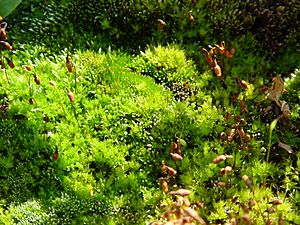Evolutionary grade facts for kids

An evolutionary grade is a group of species at the same level of organisation.
It refers to a group of animals or plants which are very similar, but which are not a clade. They have a similar morphological or physiological complexity, and they are often adapted to the same way of life.
The term was coined by Julian Huxley, to contrast with clade, which is a strictly phylogenetic unit. The use of 'grade' as a term in biology was strongly supported by Ernst Mayr, who also pointed out that the term had been used for some time before cladism.
Contents
Background
An evolutionary grade is a group of species united by similarities. These similarities led to their being given a name. But now to be a clade, the whole group from the first known member to the present day must be included.
The most commonly cited example is that of reptiles. In the early 19th century, tetrapods were put in the four familiar classes of amphibians, reptiles, birds and mammals. In this system, reptiles are defined by traits such as laying cleidoic eggs, having skin covered in scales or scutes, and having a 'cold-blooded' metabolism.
However, we now know that amphibia gave rise to early egg-laying amniotes. These gave rise to sauropsids (the ancestors of reptiles and birds) and synapsids (the ancestors of mammals. 'Reptile' is just a common term for those sauropsids which survived to the present day, minus the birds. As an everyday word, everyone understands it. But as a modern scientific term, it is no longer good, and is less used.
Paraphyletic and polyphyletic taxa often represent evolutionary grades. In some cases paraphyletic taxa are united simply by not being part of any other groups, and give rise to so-called wastebasket taxa.
Examples

- Bryophytes were long considered a natural group, defined as those land plants which lacked vascular systems. Molecular evidence shows that the bryophytes are not monophyletic since mosses, liverworts and hornworts are in fact separate lineages, with mosses closest to vascular plants. However, the three clades have a similar degree of complexity, and the "bryophyte grade" is a useful benchmark when analysing early plants – it gives information about the status of fossils which cannot always be classified into living groups.
- Fish represent a grade, as they have given rise to the land vertebrates. In fact, the three traditional classes of fish (Agnatha, Chondrichthyes and Osteichthyes) all represent evolutionary grades. Obviously, everyone will go on using the word fish; this just makes the point that they are not a monophyletic clade.
- Dinosaurs plus birds are a proper monophyletic group. Otherwise they are not.
- Labyrinthodonts are an evolutionary grade, and the group is no longer a term in taxonomy.
- Synapsids cannot be a clade unless the mammals are included.
- Nautiloids. Cladistically speaking, nautiloids are a paraphyletic group with shared primitive features not found in derived cephalopods. In other words, they are a evolutionary grade which is thought to have given rise to both ammonoids and coleoids.
Images for kids
-
The genus Australopithecus is ancestral to Homo, yet actively in use in palaeoanthropology.
See also
 In Spanish: Grado (cladística) para niños
In Spanish: Grado (cladística) para niños


